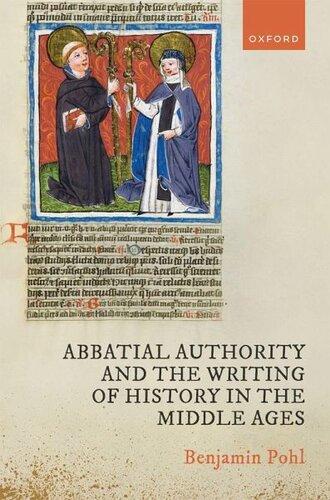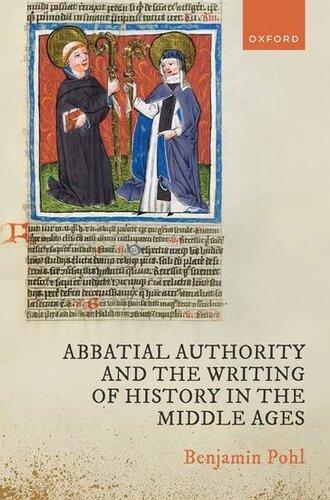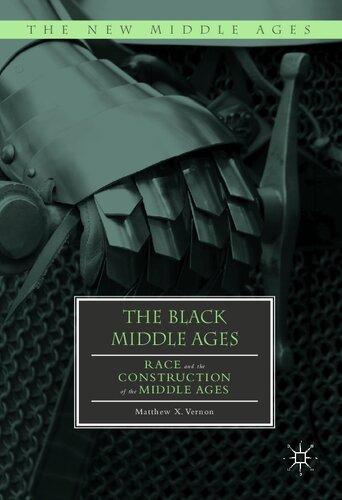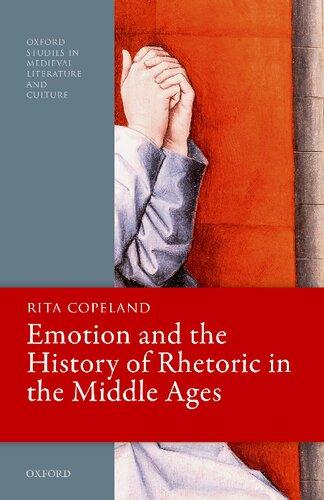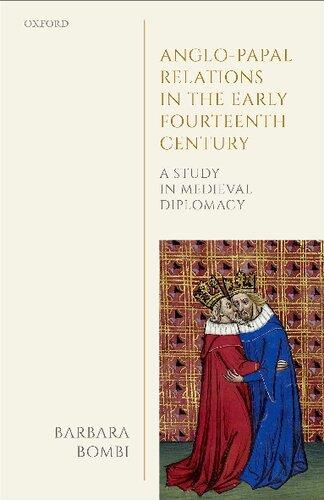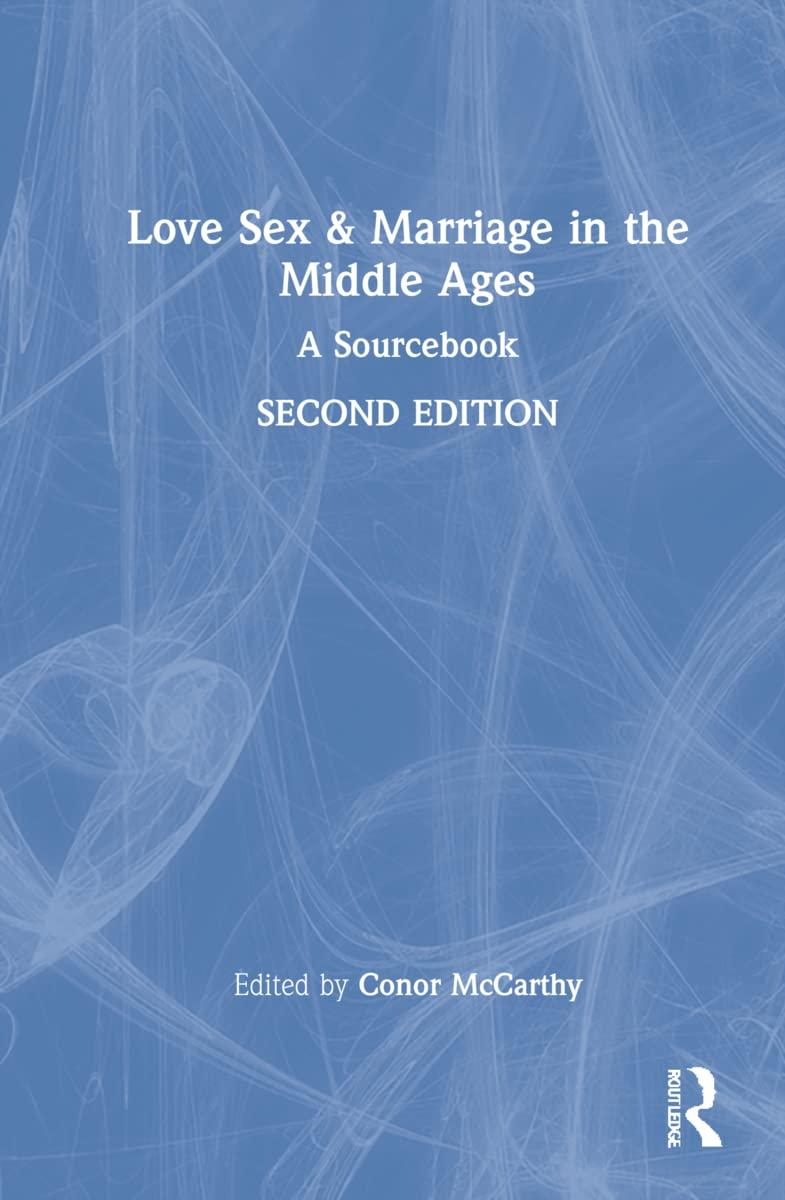England and the Papacy in the Early Middle Ages: Papal Privileges in European Perspective, c. 680-1073
Benjamin Savill
Visit to download the full and correct content document: https://ebookmass.com/product/england-and-the-papacy-in-the-early-middle-ages-pa pal-privileges-in-european-perspective-c-680-1073-benjamin-savill/
More products digital (pdf, epub, mobi) instant download maybe you interests ...
Abbatial Authority and the Writing of History in the Middle Ages Benjamin Pohl
https://ebookmass.com/product/abbatial-authority-and-the-writingof-history-in-the-middle-ages-benjamin-pohl/
Abbatial Authority and the Writing of History in the Middle Ages Dr Benjamin Pohl
https://ebookmass.com/product/abbatial-authority-and-the-writingof-history-in-the-middle-ages-dr-benjamin-pohl/
Graphic Signs of Authority in Late Antiquity and the Early Middle Ages Ildar Garipzanov
https://ebookmass.com/product/graphic-signs-of-authority-in-lateantiquity-and-the-early-middle-ages-ildar-garipzanov/ Toxicology in the Middle Ages and Renaissance Wexler
https://ebookmass.com/product/toxicology-in-the-middle-ages-andrenaissance-wexler/
The Experience of Beauty in the Middle Ages Mary Carruthers
https://ebookmass.com/product/the-experience-of-beauty-in-themiddle-ages-mary-carruthers/
The Black Middle Ages: Race and the Construction of the Middle Ages Matthew X. Vernon
https://ebookmass.com/product/the-black-middle-ages-race-and-theconstruction-of-the-middle-ages-matthew-x-vernon/
Emotion and the History of Rhetoric in the Middle Ages
Rita Copeland
https://ebookmass.com/product/emotion-and-the-history-ofrhetoric-in-the-middle-ages-rita-copeland/
Anglo-Papal Relations in the Early Fourteenth Century: A Study in Medieval Diplomacy Barbara Bombi
https://ebookmass.com/product/anglo-papal-relations-in-the-earlyfourteenth-century-a-study-in-medieval-diplomacy-barbara-bombi/
Love, Sex & Marriage in the Middle Ages; A Sourcebook
Conor Mccarthy
https://ebookmass.com/product/love-sex-a-sourcebook-conormccarthy/
FRONTMATTER
EnglandandthePapacyintheEarlyMiddleAges:PapalPrivilegesinEuropeanPerspective,c.680-1073
BenjaminSavill
https://doi.org/10.1093/oso/9780198887058.001.0001
Published:2023 OnlineISBN:9780191994586
CopyrightPage
https://doi.org/10.1093/oso/9780198887058.002.0004 Pageiv
Published:August2023
PrintISBN:9780198887058
Subject: HistoryofReligion,MedievalandRenaissanceHistory(500to1500)
Collection: OxfordScholarshipOnline
GreatClarendonStreet,Oxford,OX26DP, UnitedKingdom
OxfordUniversityPressisadepartmentoftheUniversityofOxford
ItfurtherstheUniversity’sobjectiveofexcellenceinresearch,scholarship, andeducationbypublishingworldwide.Oxfordisaregisteredtrademarkof OxfordUniversityPressintheUKandincertainothercountries
©BenjaminSavill2023
Themoralrightsoftheauthorhavebeenasserted
Allrightsreserved Nopartofthispublicationmaybereproduced,storedin aretrievalsystem,ortransmitted,inanyformorbyanymeans,withoutthe priorpermissioninwritingofOxfordUniversityPress,orasexpresslypermitted bylaw,bylicenceorundertermsagreedwiththeappropriatereprographics rightsorganization Enquiriesconcerningreproductionoutsidethescopeofthe aboveshouldbesenttotheRightsDepartment,OxfordUniversityPress,atthe addressabove
Youmustnotcirculatethisworkinanyotherform andyoumustimposethissameconditiononanyacquirer
PublishedintheUnitedStatesofAmericabyOxfordUniversityPress
198MadisonAvenue,NewYork,NY10016,UnitedStatesofAmerica
BritishLibraryCataloguinginPublicationData
Dataavailable
LibraryofCongressControlNumber:2023935783
ISBN978–0–19–888705–8
DOI:10 1093/oso/9780198887058 001 0001
PrintedandboundintheUKby
TJBooksLimited
LinkstothirdpartywebsitesareprovidedbyOxfordingoodfaithand forinformationonly Oxforddisclaimsanyresponsibilityforthematerials containedinanythirdpartywebsitereferencedinthiswork.
FRONTMATTER
EnglandandthePapacyintheEarlyMiddleAges:PapalPrivilegesinEuropeanPerspective,c.680-1073
BenjaminSavill
https://doi.org/10.1093/oso/9780198887058.001.0001
Published:2023 OnlineISBN:9780191994586
PrintISBN:9780198887058
Acknowledgements Published:August2023
Subject: HistoryofReligion,MedievalandRenaissanceHistory(500to1500)
Collection: OxfordScholarshipOnline
ThisisacompletereworkingofmyDPhilthesis,supervisedbySarahFootandexaminedbySimonKeynes andChrisWickhamin2017 ThemanydebtsIaccumulatedwhilepreparingtheoriginalthesisare acknowledgedtherein,butImustthankagaintheWolfsonFoundation,InstituteofHistoricalResearch (IHR)andRoyalHistoricalSocietyforfundingmyresearch,andthe‘Ja�é3’/‘Papsturkundendesfrühen undhohenMittelalters’project,basedattheAkademiederWissenschaftenzuGöttingenandFriedrichAlexander-UniversitätErlangen-Nürnberg,forinvitingmetoconsulttheirunpublishedmaterialsand photographiccollectionsin2015–16.ThatthesisbecamethismonographduringtheCovid-19lockdownsof 2020–21,withearliergroundworkputdownattheBritishLibrary,WarburgInstitute,IHR,Cambridge UniversityLibrary,andUniversityofEastAnglia ItwasbroughttocompletionatTrinityCollegeDublin ThroughoutthistimeIhavebeenespeciallygratefulforthesupportofDavidd’Avray,CarolineGoodson, NicholasVincent,BryanWard-Perkins,andImmoWarntjes.IndividualchapterswerereadbyKatyCubitt, TomLicence,LeviRoach,AlanThacker,FrancescaTinti,andJudithWerner,andimprovedbytheir comments JuliaCricklentinvaluablepalaeographicadvice FelicityHillhonouredthewritingpact Thelate RichardSharpegavemuchneededencouragementatacriticalearlystage.Works-in-progresswere presentedtotheGermanHistoricalInstituteMedievalSeminar,BritishAcademyAnglo-SaxonCharters Symposium,IHREarlierMiddleAgesSeminar,OxfordMedievalSeminar,andtheStAndrewsInstituteof MedievalStudiesSeminar SpecialthanksareduetoOHMandOUP,theirreader(laterself-‘revealed’as JanetNelson),andaboveallJuliaSmithasAdvisoryEditor.Anyerrorsaremyown.
Berlin,2022 p vi
ListofFigures 2.1Theearliestsurvivingpapyrusprivilege:PaschalIforRavenna,819 (243 52cm)(JE2551):Ravenna,Archivioarcivescovile,Papiron.4, insitu inthepresent-dayarchiepiscopalarchive(Arcidiocesidi Ravenna-Cervia,withpermission).33
2.2PapyrusprivilegesofJohnXIIIconcerningVic,971(JL3746–7,3750): VicArxiuEpiscopal,405–7, insitu inthepresent-dayepiscopal archive(Vic,ArxiuEpiscopal,withpermission).34
2.3Twopapyrusprivileges:(a)StephenVforNeeunheerse,891 (145 32cm:uppersectionmissing)(JL3468):Münster, LandesarchivNRWAbteilungWestfalen,B605u/StiftHeerse/ UrkundenNr.3(MarburgerLichtbildarchiv,withpermission); (b)JohnXIIIforAtóofVic,971(237 66cm;with bulla)(JL3747): Vic,ArxiuEpiscopal,406(Vic,ArxiuEpiscopal,withpermission).35
2.4Arabicmanufactorymarkonapapyrusprivilege:JohnVIIIfor Tournus,876(fragment1of8)(55cmwide;fullprivilegeis320cm inlength)(JL3052):BnF,Lat.8840(Source:gallica.bnf.fr/BnF).36
2.5 Curialis script:fromJohnVIIIforTournus,876(=Figure2.4) (fragment2of8)(Source:gallica.bnf.fr/BnF).37
2.6A ‘reform-period’ parchmentprivilege:LeoIXforBamberg,1052 (JL4283):Munich,BayerischesHauptstaatsarchiv,Bamberg.Urk. 1203(MarburgerLichtbildarchiv,withpermission).40
2.7Another ‘reform-period’ parchmentprivilege:AlexanderIIforFulda, 1064(JL4557):Marburg,Staatsarchiv,Stiftsarch.Fulda10643 (MarburgerLichtbildarchiv,withpermission).41
2.8Pre-‘reform’ BENEVALETE (detail,Figure2.3b).42
2.9Monogrammatic BENEVALETE (with ‘Komma’)(detail,Figure2.6).42
2.10 Rota (detail,Figure2.6).43
3.1 Bulla ofPaschalI(817/24)(detached,nowclippedatsides), discoveredinHerefordshire,2004: PAS HESH-ADE183 (BirminghamMuseumsTrust,CCBY-SA4.0licence).80
3.2NicholasIIforWells,1061(JL4457),contemporaryfacsimile: Wells,D&C,CF/3/2(MichaelBlandford,bypermissionofthe ChapterofWellsCathedral).100
5.1 ‘Cynedridę regine’ in Liberdiurnus V93:VaticanCity,Archivio SegretoVaticano,Misc.arm.xi,19,f.97(©2022Archivio ApostolicoVaticano;bypermissionofArchivioApostolicoVaticano, allrightsreserved).156
6.1JohnXII’sprivilegeforDunstan,960(JL3687),copyintheDunstan Pontifical:BnF,Lat.943,f.7(detail)(Source:gallica.bnf.fr/BnF).192
7.1LeoIXforCrediton-Exeter(1049/50)(JL4208),copyintheLeofric Missal:Oxford,BodleianLibrary,Bodley579,f.3v(DigitalBodleian, CC-BY-NC4.0licence).240
8.1Forgery, c.1200: ‘ConstantineI’ forEvesham, ‘713’ (JE †2149):BL, CottonCleopatraE.i,ff.64–5(BritishLibrary,withpermission).273
ListofMaps 4.1Beneficiariesofpapalprivilegesformonasteries,granting iurisdicio or comparableimmunities,514–762113
4.2BeneficiariesofpapalprivilegesformonasteriesinEngland,678–715133
6.1Beneficiariesofextantauthentic/possiblyauthenticpapal privileges,955–96190
7.1Beneficiariesofextantauthentic/possiblyauthenticpapal privileges,1049–73236
University of Birmingham user on 17 September 2023
ListofAbbreviations AAineditaActapontificumRomanoruminedita,ed.J.vonPflugkHarttung,3vols.(Tübingen,1880–8)
AAWIRegestaregumAnglo-Normannorum:theActaofWilliamI (1066–1087),ed.D.Bates(Oxford,1998)
AbingdonChartersofAbingdonAbbey,ed.S.E.Kelly,2vols.(Oxford, 2000–1)
ANParis,ArchivesnationalesdeFrance
ARTEM
Chartesoriginalesantérieuresà1121conservéesenFrance, http://telma.irht.cnrs.fr/outils/originaux/index/
ASCTheAnglo-SaxonChronicle:aCollaborativeEdition,ed. D.N.DumvilleandS.Keynes,17vols.(Cambridge,1983–)
BarkingChartersofBarkingAbbeyandWalthamHolyCross,ed. S.E.Kelly(Oxford,2021)
BathandWellsChartersofBathandWells,ed.S.E.Kelly(Oxford,2007)
BCS CartulariumSaxonicum:aCollectionofChartersRelating toAnglo-SaxonHistory,ed.W.deGrayBirch,3vols. (London,1885–93)
BLLondon,BritishLibrary
BnFParis,BibliothèquenationaledeFrance
BobbioCodicediplomaticodelMonasterodiS.ColombanodiBobbio finoall’annoMCCVIII,ed.C.Cipolla,3vols.(Rome,1918)
Böhmer-FrechK.A.Frech, RegestaImperiiIII.5.Papstregesten1024–1058, 2vols.(Cologne,WeimarandVienna,2006–11)
Böhmer-ZimmermannH.Zimmermann, RegestaImperiiII.5.Papstregesten 911–1024,2ndedition(Vienna,Cologne,Weimar,1998)
ChertseyChartersofChertseyAbbey,ed.S.E.Kelly(Oxford,2015) ChristChurchChartersofChristChurchCanterbury,ed.N.P.Brooksand S.E.Kelly,2vols.(Oxford,2013)
Chron.Mos.ChroniqueoulivredufondationdumonastèredeMouzon, ed.andtrans.M.Bur(Paris,1989)
Chron.Rames.ChroniconabbatiaeRameseiensisasaec.x.usqueadan. circiter1200,ed.W.D.Macray(London,1886)
Chron.Winch.TheWinchcombeandCoventryChronicles:Hitherto UnnoticedWitnessestotheWorkofJohnofWorcester,ed. andtrans.P.A.Hayward,2vols.(Tempe,2010)
September 2023
CS I
CouncilsandSynods,WithOtherDocumentsRelatingto theEnglishChurchI, A.D.871–1204,ed.D.Whitelock, M.Brett,andC.N.L.Brooke,2vols.(Oxford,1981)
DavisG.R.C.Davis, MedievalCartulariesofGreatBritainand Ireland,rev.C.Breay,J.Harrison,andD.M.Smith (London,2010)
Deantiq. WilliamofMalmesbury, DeantiquitateGlastoniensis Ecclesie,ed.J.Scott,inJ.Scott, TheEarlyHistoryof Glastonbury:anEdition,TranslationandStudyofWilliam ofMalemsbury’sDeantiquitateGlastonieEcclesie (Woodbridge,1981),pp.40–172
D&CDeanandChapter
ECEETheEarlyChartersofEasternEngland,ed.C.R.Hart (Leicester,1966)
GlastonburyChartersofGlastonburyAbbey,ed.S.E.Kelly(Oxford,2012)
GP WilliamofMalmesbury, GestapontificumAnglorum:the HistoryoftheEnglishBishops,ed.andtrans. M.WinterbottomwiththeassistanceofR.M.Thomson, 2vols.(Oxford,2007)
GR WilliamofMalmesbury, GestaregumAnglorum:the HistoryoftheEnglishKings,ed.andtrans.R.A.B.Mynors, completedbyR.M.ThomsonandM.Winterbottom, 2vols.(Oxford,1998)
HA Bede, Historiaabbatum,in AbbotsofWearmouthand Jarrow,ed.andtrans.C.GrocockandI.N.Wood (Oxford,2013),pp.21–75
HE Bede, EcclesiasticalHistoryoftheEnglishPeople,ed.and trans.B.ColgraveandR.A.B.Mynors(Oxford,1969)
HN Eadmer, HistorianovoruminAnglia,ed.M.Rule(London, 1884)
HS CouncilsandEcclesiasticalDocumentsRelatingtoGreat BritainandIreland,ed.A.W.HaddanandWilliam Stubbs,3vols.(Oxford,1869–78)
JE,JK,JLP.Jaffé, RegestapontificumRomanorumabconditaecclesia adannumpostChristumnatumMCXCVIII,2ndedition, rev.W.Wattenbach,S.Loewenfeld,F.Kaltenbrunner,and P.Ewald,2vols.(Leipzig,1885–8)
J³P.Jaffé, RegestapontificumRomanorumabconditaecclesia adannumpostChristumnatumMCXCVIII,3rdedition, rev.K.Herbers,M.Schütz,J.Werner,etal.,4vols.todate (Göttingen,2016–)(Usuallyonlycitedwhennoentryin 2ndedition)
K
CodexdiplomaticusaeviSaxonici,ed.J.M.Kemble,6vols. (London,1839–48)
LDLiberdiurnusRomanorumpontificum,ed.HansFoerster (Bern,1958)
LPLeLiberpontificalis,ed.L.Duchesne,3vols.(Paris, 1884–1957)
MalmesburyChartersofMalmesburyAbbey,ed.S.E.Kelly(Oxford,2005)
MGHEpp. I–VII MonumentaGermaniaeHistorica.Epistolae I–VII,7vols. (Berlin,1887–1928)
MGHFormulaeFormulaeMerowingicietKaroliniaevi,ed.K.Zeumer, MonumentaGermaniaeHistorica.LegesV (Hanover, 1886)
NorthernHousesChartersofNorthernHouses,ed.D.A.Woodman(Oxford, 2012)
PASPortableAntiquitiesScheme,https://finds.org.uk/database
PeterboroughChartersofPeterboroughAbbey,ed.S.E.Kelly(Oxford, 2009)
PLPatrologiaecursuscompletus,seriesLatina,ed.J.P.Migne, 221vols.(Paris,1841–64)
PRDPPontificumRomanorumdiplomatapapyraceaquaesupersunt intabulariisHispaniaeItaliaeGermaniae,ed.C.deSilva TaroucaandC.Erdmann(Rome,1929)
PROLondon,TheNationalArchives,PublicRecordOffice PUUPapsturkunden896–1046,ed.H.Zimmermann,3vols. (Vienna,1984–9)
PUUEnglandPapsturkundeninEngland,ed.W.Holtzmann,3vols. (Berlin,1930–52)
PUUFrankreichPapsturkundeninFrankreich,ed.W.Wiederhold,7vols. (Berlin,1906–13)
PUUIle-de-FrancePapsturkundeninFrankreich,NeueFolge7.Nördliche Ile-de-FranceundVermandois,ed.D.Lohrmann (Göttingen,1976)
PUUItalienPapsturkundeninItalien.ReiseberichtezurItaliaPontificia, ed.P.Kehr,6vols.(VaticanCity,1977)
PUUSaint-DenisPapsturkundeninFrankreich,NeueFolge9.DiözeseParis II.AbteiSaint-Denis,ed.R.Grosse(Göttingen,1998)
PUUSpanienPapsturkundeninSpanien.VorarbeitenzurHispania Pontificia,ed.P.Kehr,D.Berger,K.Herbers,and T.Schlauwitz,3vols.(Berlin,1926–2020)
Reg. GregorytheGreat, Registrumepistularum,ed.D.Norberg, CorpusChristianorumSeriesLatina140–140A,2vols. (Turnhout,1982)
Downloaded from
by University of Birmingham user on 17 September 2023
RochesterChartersofRochester,ed.A.Campbell(Oxford,1973)
SP.H.Sawyer, Anglo-SaxonCharters:anAnnotatedListand Bibliography (London,1968);rev.S.E.Kelly,R.Rushforth etal.onlineathttps://esawyer.lib.cam.ac.uk
StAlbansChartersofStAlbans,ed.J.Crick(Oxford,2007)
StAugustine’sChartersofStAugustine’sAbbey,CanterburyandMinsterin-Thanet,ed.S.E.Kelly(Oxford,1995)
StPaul’sChartersofStPaul’ s,London,ed.S.E.Kelly(Oxford,2004)
SherborneChartersofSherborne,ed.M.A.Donovan(Oxford,1988)
VCVitaCeolfridi,in AbbotsofWearmouthandJarrow,ed. andtrans.C.GrocockandI.N.Wood(Oxford,2013), pp.77–121
VSW
WBEASE
EddiusStephanus[StephenofRipon], TheLifeofBishop Wilfrid,ed.andtrans.B.Colgrave(Cambridge,1927)
M.Lapidge,J.Blair,S.D.Keynes,andD.Scragg,eds., The WileyBlackwellEncyclopediaofAnglo-SaxonEngland, 2ndedition(Oxford,2014)
WinchesterNMChartersoftheNewMinster,Winchester,ed.S.Miller (Oxford,2001)
Numbersin bold throughouttheapparatusofthisbookrefertopapalprivilegesin EnglandcataloguedintheAnnotatedHandlist(Chapter3):thereaderwill findtheir fullcitationdetailsthere.
Introduction Asallfellsilentafterthereading,Berhtfrith,theking’stopman, spoketothearchbishop: ‘Itwouldpleasethoseofuswhoneedan interpretationtohearwhattheapostolicauthorityhastosay.’ The archbishopreplied: ‘Decisionsoftheapostolicseeareexpressed inalanguagewhichistortuousandenigmatic – nevertheless,each documentdoesrevealasingleunderstandingofthismatterat hand.Iwilluntangleatleasttheirsenseinbrief.’¹
Oursurvivingevidenceatteststotheacquisitionofapurportedsixty-seven papalprivilegesrelatingtoEnglandintheearlymiddleages.Someare authentic,manyforged,andonlyafewthesubjectofextendedanalysis: Berhtfrithwouldbealarmedtolearnthattherestillremainsmuchto unravel.Theabsenceofadedicatedstudyhasnotgoneunnoticed.Way backin1839JohnMitchellKemble,thegodfatherofmodernAnglo-Saxon studies,promisedavolumewhichfailedtomaterialisebeforehisuntimely death.Attheturnofthepresentcentury,twoofthe field’spre-eminent scholarsreiteratedthecallforthis ‘urgentdesideratum’.²Evenhadtheynot, therecurringappearanceofthesedocumentsacrossalmostallthe loca classica ofAnglo-Saxonhistoriographycouldnotescapeanystudentof theperiod.Papalprivileges(documentsissuedinthenamesofthebishops ofRome,grantingorconfirmingspecialrightstoindividualsorinstitutions) meetwithrepeatpraiseintheworksofBedeandhiscontemporariesinthe Northumbriangoldenage.Theystandoutamongthedocumentaryrecords ofthe ‘MercianSupremacy’.Someofthemostfamousroyaldiplomasofthe tenthandeleventhcenturycitethemasprecedents,whilethesuspicious discoveryoflong-lostprivilegesischaracteristicofthearchivalcreativityof post-ConquestEngland.Theyaretiedtothenamesofsuchcelebrated figuresasBenedictBiscopandAldhelm,OffaandCynethrythofMercia,
¹ VSW,60,p.130. ²Wormald, ‘Æthelwold’,p.200,n.89;Keynes, ‘Foreword’,p.xxi; WBEASE,p.362. EnglandandthePapacyintheEarlyMiddleAges:PapalPrivilegesinEuropeanPerspective,c.680–1073 BenjaminSavill,OxfordUniversityPress.©BenjaminSavill2023.DOI:10.1093/oso/9780198887058.003.0001
2
andSaintsWilfrid,Dunstan,Æthelwold,andEdwardtheConfessor.We findthemintextsofdiversegenres:history,chronicle,andhagiography; homily,gospelbook,andliturgicalcollection;usuallyinLatin,butoccasionallyinOldEnglishtranslation.Theymayhaveevenmadetheirwayintoour archaeologicalrecord.Yetstillnostudyhasbroughtallthismaterial togetherandanalyseditonitsownterms.That’sthetaskofthismonograph. Theabsenceofsuchanexaminationcanseemstrange,sincepapal privilegesrepresentapointofintersectionbetweentwoofthemajorareas ofresearchinterestinAnglo-Saxonhistoriography:charterstudies,andthe relationshipbetweentheearlyEnglishandRome.ThestudyofAnglo-Saxon chartershasbeenrevolutionisedoverthepasthalf-century.Thankstoa numberofinfluentialsecondaryworks,andthesteadyappearanceofaseries ofhigh-calibrecriticaleditions,asophisticatedengagementwiththesetexts hasnowbecomeahallmarkofscholarshiponearlymedievalEngland.³ Nevertheless,thesestudieshavetendedtofocuspredominantlyonwhatone mightcallthenativecomponentofAnglo-Saxondocumentaryculture,with relativelylittleconsiderationaboutwhathappenedwhenanadditional, exoticgenreofwritteninstrumentwasimportedintothissameenvironment (andasweshallsee, ‘exotic’ istherightwordforthesehuge,metres-long scrollsofMediterraneanpapyrus).Thisdoesnotmean,ofcourse,that Anglo-SaxonstudieshasshiedawayfromexploringmainlandEuropean influencesandconnectionsinthehistoryofpre-ConquestEngland.Sinceat leastthetimeofthegroundbreakingworkofWilhelmLevison,thishas constitutedasignificantsubstratumofthe field,andscholars takingcues fromBedehimself haveoftenplacedEngland’srelationshipwithRome anditsbishopsattheforefrontoftheseinvestigations.⁴ Insomecasesthat ‘emotionalconnection’ and ‘closerelationship ’ (or ‘specialrelationship ’) withthepapacyhasbeenperceivedasa ‘characteristicphenomenonofthe Anglo-Saxonperiod’,perhapsexceptionallyso,whileonescholarhasgone asfarastoidentifyRomeastheAnglo-Saxon ‘capital’ . ⁵ Beyond,however, Levison’sownmajorcontributions,thedocumentaryaspectsofthisrelationshiphave,untilquiterecently,⁶ notalwaysbeensubjectedtothesame kindofattentionoranalyticalrigourasoneisusedtoseeingelsewhere. Whendiscussionhastakenplace,ithasoftencentredaroundeitherthe earliestconversion-eralettersknownfromBedeandGregorytheGreat’ s
³ WBEASE,pp.97–9,102–3,withbibliography.
⁴ Levison, England; WBEASE,pp.359–62,409–10,withbibliography.
⁵ Ortenberg, ‘Anglo-SaxonChurch’,pp.31–2,58–62;Howe, ‘Rome’
⁶ HereIreferespeciallytotheimportantworkofSusanKelly,JoannaStory,and FrancescaTinti.
on 17 September 2023
Register,or,attheotherendofthespectrum,thepost-Conquest ‘Canterbury forgeries’,principallyofinteresttoAnglo-Normanistsandtwelfth-century specialists.Accordingly,therichinsightsintoearlyEnglishreligion,politics, andsocietymadethroughadvancesinAnglo-Saxoncharterstudiesover thepastfouror fivedecadeshavenotextendedasfarastheymightinto therealmofAnglo-papalcommunications,despitetherelativewealthof materialavailable.
Moststraightforwardlythen,thisbookconfrontsthisweakpointinthe scholarshipbyinterrogatingthefullcorpusofpapalprivilegesinearly medievalEnglandwiththatsamedegreeofscrutiny.Doingsoisabout more,however,thansimply fillingthegaps.Itisamajorcontentionof thisstudythatpapalprivilegeshaveausefulnessforhistorianswhichfar surpasseswhathashithertobeenexpectedofthem,atleastbyAngloSaxonists.Let’sstatethisemphatically:papalprivilegessurviveasagenre totallyuniqueamongourwrittensourcesfortheearlymedievalwest. Nowhereelse,inthisageoffragmentedpoliticalandtextualcultures,do we findanothercaseofasingletypeofwrittendocumentproducedand authenticatedatasinglelocation,yetsoughtby,andtransmittedto,individualsandinstitutionsfromdiversesocietiesacrossEurope,oftenones separatedbydifferentpoliticalconfigurations,andsometimesimmense distances.Itaddsanexcitingnewdimensiontothesortsofquestionswe canaskaboutearlymedievalEngland,ifwereflectonthefactthatprivileges muchlikethoseweseeattheJarrowofBede ’sdaycouldalsobefound withinthespaceofafewdecadesatthemonasteriesofBenevento,Farfa,and Fulda.Or:thatonerarewitnesstoMercianinheritancestrategiesexistsonly asagenerictemplateforscribespreservedinasinglenorth-Italianmanuscript,theearliestextantcitationofwhichcomesfromafewdecades later,onastill-survivingEgyptianpapyrusaddressedtopost-Byzantine Ravenna.Orindeed:thatanow-lostprivilegesoughtinpersonatRome byArchbishopOswaldofYorkwouldhavehaditsimmediateparallelsin documentsissuedforhiscounterpartsatLatinEurope’sotherfrontiers, atMagdeburg,Salerno,andCatalanVic.Reflectiveworkoncomparative methodologyhasstressedtheneedforhistorianstocontrastonly ‘like withlike’,limitingcomparisonstotightlycontrolledsharedphenomena (e.g.bishops,castles,communes,coins)thatmightserveas spie (‘peepholes’) intothewiderfabricofsociety.⁷ Ascloselycomparable,sometimesnearidenticaltexts,producedunderthe ‘control’ ofasingleissuingbody,yet
of Birmingham
on 17 September 2023
Wickham, ‘Problems’,withreferencetoGinzburg, ‘Spie
4
foundbetweendiversesocietieswithotherwisefewelementsofextantsource materialincommon,papalprivilegeshavethepotentialtoserveasjustsuch spie.Itisapotentialsofarlargelyuntapped.Thisdoesnotmean,ofcourse, thatwecanjustthinkofprivilegesassimpleportalsbetween,say,the ThamesValleyandValTrebbia,allowingustojuxtaposethetwodirectly. Asweshallsee,thegreatdifferencesbetweentheexistingconditionsand frameworksofreferenceofsuchsocietiesmakestheapplicationofprivileges ascompletelystraightforwardcomparatorsalmostimpossible.Butthefact thattextsmuchlikethoseweareseekingtounderstandinEnglandcouldbe foundelsewhereacrossthecontemporaryLatinwestaddstwocrucial dimensionstothisstudy.Firstly,wewillnotbeabletospeakwithmuch authorityaboutpapalprivilegesinearlymedievalEnglandunlesswesee howelsetheymanifestedthemselvesthroughoutEurope.Secondly,adoptingsuchanapproachwilltakethismonographbeyondabasicstudyofa neglectedgenreofAnglo-Saxonevidence,andtowardsafarwider-ranging investigation,whereinwemightpinpointmomentsatwhicheventsin Englandcorrelatedorcontrastedwiththoseinothersocieties,andaskwhy.
I.StateofResearch LookingoutsideEnglandthereforerequiresthinkingbeyonditshistoriographicalboundaries.Here,however,theworkofthehistorianofpapal privilegesinEnglandbecomesnotchallenged,butvastlyenriched:the scaleofoutputinthis fieldisimmense.Foratleasttheearlymiddleages, thevastbulkofworkonpapaldocumentshasbeen,andremains, Germanophone.Itsrootsandmostsignificantadvanceslayinthesame ‘goldenage’ ofGermantextualscholarshipthatsawthegloryyearsof the MonumentaGermaniaeHistorica. ⁸ Takingoffinthelastdecadesof thenineteenthcenturyandstillenduringtothisday,multi-volumeprojects byGermanophonescholarsonpapaldocuments(Papsturkunden)have dominatedanddefinedthe fieldasitnowstands,intheformofregisters (Jaffé,1851;secondedition1885–8;thirdedition2016–;theGöttingen Academy’ s Pontificia series,1906–;the RegestaImperii ,1968–),critical editions(theGöttingen Papsturkunden series,1896–;theAustrian Academy’ s Papsturkunden896–1046,1984–9;the Monumenta itselffrom
⁸ Wood, ModernOrigins,pp.156–61.
the1890s),anddiplomaticmanuals.Whiletheseprojectsfedintoatradition ofgrand-typenarrativehistoriographythatreacheditsapogeeinthe mid-twentiethcentury,⁹ theyalsoappearedindialoguewithanumberof importantstudiesexploringlargelydiplomaticproblems,suchastheuse offormularybooks,thetechnologyandaestheticsofthedocuments (script,layout,writingsupports),andsuppositionsaboutpapalchancery organisation.¹⁰ QuitewhytheGermanhistoriographicaltraditionhas investedsomuchintopapalhistoryisnotself-evident,andoneshouldat leastbeconsciousofthepoliticalbackgroundthat firstsetthesegearsin motion.Althoughtherootsofaconfessionalisedscholarlypreoccupation abouttheroleofthepapacyinsacredhistorydatebacktothepublishing warsoftheReformation,¹¹theinstitutionalisationofmodernpapal historiography andwithit,theelevationof Papsturkunden toakindof canonicalstatusinthestudyofEuropeanlegalandconstitutionalhistory mustoweagooddealtoanumberofintersectingepisodesinlate nineteenth-centurystatecraft.Iftheprofessionalisationofthehistorical disciplineandthematurityofthe Monumenta anditsrelatedprojects werefuelledbycontemporaryGermannationalismandstate-building,the kindsofsubjectmatterandsourcematerialtheyprioritisedalsodepended uponimmediatedevelopmentsinconfessionalhighpolitics.Themodern birthofearlymedievalstudiesinGermanycannotbeviewedapartfromthe TakingofRomeanddissolutionofthePapalStatesin1870;theconclusion oftheFirstVaticanCouncilandtriumphofUltramontanismthatsameyear; theCatholicrevivalandPrussian-Vatican ‘culturewar’ ofthesubsequent decade;followedbytheopeningoftheVaticanArchivesin1882and,in consequence,thefoundationoftheGermanHistoricalInstituteatRomesix yearslater.¹²Wethereforeneedtobewaryofsomeofthestatistand confessionalbaggagethatthis fieldinevitablybrings.Lessobviously,one alsoneedstobeconsciousthatthepreoccupationofthat findesiècle generationofresearchersintheunravellingofthehiddenmysteriesofthe papalchancery,andintheediting,ordering,andregistrationofpapal documentsasanendinitself,wasinnosmallpartaprojectionofthe hyper-bureaucraticmentalitiesoftheirlatenineteenth-centurystate.¹³ Registers,editions,anddiplomaticanalysescan,anyway,onlytakeusso
⁹ Fuhrmann, ‘Papstgeschichtsschreibung’,pp.157–61;Noble, ‘Morbidity’,pp.506–11.
¹⁰ SeeabovealltheworkofPflugk-Harttung,Sickel,Kehr,Santifaller,andRabikauskas.
¹¹Fuhrmann, ‘Papstgeschichtsschreibung’,pp.143ff.
¹²Elze, ‘DeutscheHistorischeInstitut’;ClarkandKaiser,eds., CultureWars
¹³Mersiowsky, Urkunde,i,pp.25,29.
6
far.Withoutthem,modernscholarshiponpapalhistorywouldbe impossible.Butdefiningthesourcematerialisonlythebeginningofanalysis,andwemustnotfallintothetrapof fine-tuningandfetishisingthe criticaltextsof Papsturkunden attheexpenseoffurtherinterpretationand theapplicationofwiderhistoricalquestions somethingakintowhatMark Mersiowskyhascalledthe cartaedita,causa finita approachofcertain strandsofdiplomaticscholarship.¹⁴
Importantandwider-ranginginterpretiveworkonearliermedieval Papsturkunden hasneverthelessemergedinthelatestgenerationof Germanophonescholarship,muchofitaby-productofthosemorerecent institutionalefforts.SpecialiststudiesbyHans-HenningKortümandJochen Johrendt,togetherwithaseriesofcollectedvolumespublishedbythe GöttingenAcademyhavedemonstratedwhatscholarscanachievethrough atrans-regionalapproachtothisuniquecorpus.Thesehaveappliedquestionsaboutcommunication,memory,preservation,beneficiaryinfluence, andregionalidentityacrossthiscontinent-widebodyofevidence,witha viewinparticulartotheworldsofitsrecipients,ratherthanRome.¹⁵ This researchhasappearedalongsideasmallernumberofstudiesworkingwithin whathassometimesbeencalledthe ‘newdiplomatic’,andhasfocusedupon principallynon-verbalaspectsofpapalprivileges,analysingthemasmaterialartefactsandvisualinstrumentsofpower.¹ ⁶ Together,theseprojectshave indicatedhowmuchispossibleifweemancipate Papsturkunden fromthe confinesofspecialisttextualanalyses,thinkingofthemasmorethanjust evidencefortheadministrativecapacitiesofpapalRome.Thesestudieshave, however,entirelypassedoverEngland.Theremaybegoodreasonsforthis. Farfewerpapalprivileges(andnooriginals)survivefromearlymedieval England,makingitextremelydifficulttointegratethismaterialintothe relativelybig-datacomparativeanalyseswhichthesestudiessometimes prefer.Indeed,theEnglishevidenceiscomparablyweakestfromthelater ninthtoearlytwelfthcenturies,theperiodwithwhichthismostrecentwave ofscholarshiphaslargelyconcerneditself.Nevertheless:whateversensible researchconsiderationsmightliebehindthisgenerationalmoveawayfrom
¹⁴ Mersiowsky, ‘TowardsaReappraisal’,p.19(‘charteredited,caseclosed’).
¹⁵ Kortüm, ZurpäpstlichenUrkundensprache;Johrendt, Papsttum;Johrendt, ‘Empängereinfluß’ ; JohrendtandMüller,eds., RömischesZentrum;JohrendtandMüller,eds., Romunddie Regionen;HerbersandFleisch,eds., Erinnerung;Herbers,Engel,andLópezAlsina,eds., Das begrenztePapsttum;HerbersandJohrendt,eds., PapsttumunddasvielgestaltigteItalien;Große, ed., L’acte;HerbersandKönighaus,eds., VonOutremer;HerbersandMüller,eds., Lotharingien ¹⁶ Seebelow,Chapter2.
on 17 September 2023
theAnglo-papalevidence,itslong-termeffecthascertainlybeennegative.It hascementedatrendwithincontinentalworkontheearlymedievalpapacy thattreatsEnglandasamarginaloutsider,and,withinAnglo-Saxonstudies, donelittletoremedyareluctancetoengagewithnon-Anglophonedevelopmentsinpapalhistoriography.
Thesingleareainwhichscholarshiponearlymedievalpapalprivileges hasseriouslyexpandedbeyondtheconfinesofGerman-languagespecialist literature,meanwhile,hasbeenindedicatedstudiesof ‘exemption’ and ‘protection ’.Thistopichasseenimportantcontributionsoverthepast centuryfromscholarsacrossEuropeandNorthAmerica,coveringmaterial frombothAnglo-SaxonEnglandandcontinentalEurope.Thedocuments nowlabelledunderthesetermswereundoubtedlyimportant,andthisbook willturntothemonseveraloccasions.Nevertheless,thepredominanceof thissubjectacrossmuchofthescholarshiphasprobablyhadadistorting effectonwiderperceptionsofpapalprivilegesinearlymedievalEurope. Firstly:grantsofthiskindmadeuponlyonepartoftheprivilegesissuedby thepopes,whofromatleastthelatereighthcenturybecameincreasingly preoccupiedwithguaranteesforpre-existingchurchproperty.Focusingso muchattentionuponthesequiteparticularkindsofprivilegehastherefore perpetuatedafalseimpressionthat ‘papalprivileges’ wereessentiallysynonymouswithgrantsof ‘protection’/‘exemption’,anapproachthatsignificantlymisrepresentsthenatureofmostdocumentsactuallypetitioned fromRomeacrossthesecenturies.Secondly:thesestudiestypicallylean towardsapronouncedteleologicalposition,particularlyoneofalegalistconstitutionalistbent,somethingwhichcontinuestohauntmanymodern approachestoearlypapalhistory. ‘Protection’ and ‘exemption’ would emergeashighlyimportantlegalcategoriesinthecentralmiddleages, havingaparticularsignificance,forexample,inthehistoryofCluniac monasticism.Butinsearchingprimarilyforthe ‘growth’ or ‘origins’ of thesehigh-medievalphenomenaacrossearliercenturies,manystudies showonlylimitedconcernforearlymedievaldevelopmentsintheirown right,preferringinsteadtotracealinewhichculminatestowardstheir author’speriodofcoreinterest.EvenBarbaraRosenwein’sexcellent NegotiatingSpace (1999)betraysthistendency,beginningwithUrbanII’ s privilegingofClunyin1095,beforetracingacross150pagesthedevelopmentsleading towards thatpoint,andthenendingwithanexcursusonits implicationsfortheUnitedStatesConstitution.
Amidstallthis,dedicatedworkonpapalprivilegesinearlymedieval Englandhasnot flourished.Earlytwentieth-centurycontributionsmade
byGermanscholarsfromthe Monumenta school theearlymedieval sectionsofWaltherHoltzmann ’ s PapsturkundeninEngland (1930–52), andLevison’ s EnglandandtheContinent (1946) setanexceptionally highstandard,andtheirworkremainsindispensable.Whatfollowswill verymuchbeanexerciseinstandingongiants’ shoulders.Yetthesestudies remainnotjustunsurpassedbutalsonotsubstantiallydevelopedupon. TheGöttingenAcademy ’splanned AngliaPontificia projectcurrently sitsonhiatus.Morerecentpublicationssurveyingthepastandfutureof papaldocumentaryscholarshipseemalmosttomoveEnglandoutofthe picturealtogether,celebratingtheachievementsmadeoverthepastcentury instudyingpapaldocumentsatthe ‘ core ’ ofEurope(Italy,France, Germany),whilelookingforwardtofutureprogressinresearchonits ‘peripheries’ (Iberia,centralandeasternEurope,Scandinavia).¹⁷ Itmay notbetooearlytodetectparallelsheretothecurrentpoliticalmoodin Europe.ThisdisinclinationamongpapalspecialiststoengagewithEngland has,anyway,notalwaysbeencompensatedbyenthusiasmwithinAngloSaxonistscholarship.HansHubertAnton’sten-pagestudyof1975onthe authenticityofanumberofBede-eraEnglishprivilegesremainsperhapsthe mostcitedwork.¹⁸ TheBritishAcademy’ s Anglo-SaxonCharters series (1973–),whilemakinginvaluablecontributionsinthisarea,hasremained inconsistentfromvolumetovolumeastowhetherornottoincludepapal documentsaspartoftheEnglishdocumentarycorpus:whentheydoappear, theyhavesometimesbeenrelegatedtoappendiceswithmorelimitedcommentary.Thisisofcourseperfectlyreasonable,giventhatpapaldocuments didnotfallwithintheoriginalremitoftheBritishAcademyproject,which alreadyhasthetaskofcoveringalmosttwothousandEnglishcharters,writs, andwills.Butaresultofthisdividedtreatmentisthat,whileAnglo-Saxon charterscholarshiphasexplodedsincethe1970s,andatthesame timenumerousvolumesofbothtechnicalandinterpretiveworkhave appearedasaresultofwell-funded,institutionalisedcontinentalresearch on Papsturkunden ,thesetwostrandsofscholarshiphavenotonlylargely failedtointeract,buthavearguablybecomeincreasinglyalienatedfrom oneanother.Considering,asoutlinedabove,theimportantpotentialof papalprivilegesascomparativetools,thispartingofwayshasimplications beyondtherelativelynarrowworldofdiplomatic.Itmayhavehada detrimentaleffectuponhowbothAnglophoneandcontinentalscholars havebeenpreparedtosituateAnglo-SaxonEnglandwithinearlymedieval Europemoregenerally.
II.ThisBook:ScopeandStructure Thismonographthereforesetsouttoexplorewhatwecanlearnfromthe survivingevidenceforpapalprivilegesinearlymedievalEngland.Itfully engageswiththeadvancesmadeinbothAnglo-Saxonstudiesandspecialist papalhistoriographyoverthepastcentury,whilealsousingtherare, Channel-crossingpotentialprivilegesoffertoinvestigatewhatinsights theymightgenerateaboutEnglandwithinthewiderEuropeanpicture.It worksonthebasicpremisethatweshouldnottreatpapaldocumentsin Englandseparatelyfromeitherthe ‘native’ Englishtextsamongwhichthey survive,northehugecorpusofalmost800papalprivilegesacquiredelsewhereacrosstheLatinwestthroughoutthissameperiod,ofwhichthey comprisedonlyasmallpart(seeTable1.1).¹⁹ Itdoessoontheconviction thatstudyingtheminisolationcreatesafalsedividethatmayhavemade littlesenseinlightofcontemporarypractices;thatsuchanapproachallows
Table1.1 AuthenticpapalprivilegesinwesternEurope,590–1073:thestateof theevidence
ItalyTransalpine Europe IberiaEngland GregoryIto
SergiusI (590–701) 21 (18ofwhich GregoryI) 12–17 (7ofwhich GregoryI) 1 (only GregoryI) 6 (1ofwhich GregoryI) + 4deperdita
JohnVIto HadrianI (701–795) 1111–1202 +1deperditum
LeoIIIto JohnIX (795–900) 306424 +1deperditum
BenedictIVto GregoryV (900–999) 61106131–3 +1deperditum?
SilvesterIIto AlexanderII (999–1073) 210175237–8 +4deperdita
¹⁹ Table1.1: figuresforEnglandaretakenfromChapter3;thoseforelsewherearebasedon Santifaller, ‘Verwendung’,updatedbycurrentscholarship.Theaimofthistableissimplyto makeclearataglancethescaleanddistributionofthe known evidence.
ustogeneratenewobservations,connections,andcomparisonssofar overlooked;andthatitalsoprovidesamuchneededoccasiontobring togetherbodiesofscholarshiptraditionallydividedbetweenspecialist fields. Itaddressestextualissuesinthesourcematerialandestablishesapreliminarygroundworkforaworkablecorpusofauthenticallyearlymedievalpapal privilegesinEngland,buttreatsthisasawaytowardsaskingwiderandmore interestingquestions,ratherthanasanendinitself.Moreover,whileastudy ofthissizecanonlyaimtodoasmuchastofocusprincipallyuponEngland, itsexplorationsofwhatwemightgainfromtakingamoreregionalised, petitioner-focusedapproachtoengagementwiththepapacyinthisperiod will,Ihope,beofvaluetothoseworkingonotherpartsofEuropeaswell.In astill-relevantinterventionof1995,TomNoblecomplainedofthe ‘ morbidity’ ofmuchhistoricalwritingontheearlymedievalpapacywithin thewider fieldofearlymedievalstudies.Whateverthetransformationsof thelatterdisciplinesincethemid-twentiethcentury,muchworkwithin theformerhasremainedcommittedtotracingoutalinearnarrative, gearedaroundthegradualrealisationofa fixedpapal ‘idea’ alonga ‘series ofpolitical-diplomaticencounters’,ultimatelylookingforwardtoits supposedculminationunderInnocentIII(1198–1216)orBonifaceVIII (1294–1303).²⁰ Ifitisnowtruethatthiskindofmaster-narrativenolonger hasmanyadvocates,analternativeapproachhasyettotakeitsplace.This book,focusingupononeregion ’sengagementwithpapaldocumentary cultureatparticularmomentsacrosstheearlymiddleages andviewing thoseengagementsprimarilyfromtheperspectiveofthatregionalsociety, ratherthanaccordingtoanydevelopmentalnarrativeofthepapalcentre seekstocontributetoanewwayofwritinglong-formearlymedievalpapal historywhichmightchallengeatleastsomeofthe ‘moribund’ tendencies identifiedbyNoble.
Asforchronology,thisbookcoverstheperiodfrom c. 680upto1073: thatis,fromthepointaroundwhichourevidenceforauthenticmonastic privilegesintheEnglishkingdomsbegins,uptothedeathofAlexanderII (1061–73).AlthoughChapter3providesareviewofallgenuineandforged privilegesfromtheGregorianmissions(597–604)onwards,thethree authentictextsfromtheseearliestdecadespertaintotheorganisational effortsoftheconversion,atopicwhichhasalreadyenjoyedextensive treatment.Thestudyproperthereforecommenceswiththepontificateof
Agatho(678–81),whenwe firstseeEnglishmonasticleadersheadingto Rometoacquireprivilegesinperson.Endingat1073isamorearbitrary decision.Butastudyofthissizecoveringmorethanfourcenturieswould haveonlyalimitedusefulness,andthefactthatacquisitionsofprivilegesin EnglandfallsilentforagenerationfollowingtheendofAlexander’ spontificate,togetherwithitsroughproximitytotheNormanConquest,makesit anappropriatepointatwhichtobringthisearlymedievalinvestigationtoa close.Altogetherthisperiodgivesussixty-sevenpurportedprivilegesfrom theseventhtoeleventhcenturies,ofwhichjustunderhalfcanbeconsidered authentic.
Anecessarycaveat:thereislittlechancethatthis figureaccuratelyreflects thefullnumberofacquisitionswhichactuallytookplace.Historiansofthe earlymiddleagesarenowmoreattunedthanevertoproblemsofarchival lossesandhowtheymighthavewarpedourunderstandingofthepast.²¹ Northumbria’searlymedievalrecordshavecomedowntousinastateof especialdevastation,andinpartsofthisbookobservationsabout ‘England’ refermoreaccuratelytotheSouthumbrianpolities.Itisalsothecase,aswe willseeinChapter5,thatthedestructionandmutilationofdocuments couldoccurwithinacontemporarysettingthatwasfarfromaccidental. Nevertheless,thereisstillreasontobelievethatwhenitcomestopapal privileges,thesurvivingrecord,forallitsveryrealproblems,hasnot distortedourpictureofearlymedievalrealitybeyondallrecognition.²² Archivallossespredominantly,ifnotexclusively,affectephemera(e.g. lettersoftransitoryimportordeedsconcerningperishables),layorprivate charters(whichinAnglo-SaxonEnglandcouldberenderedinthevernacular,andthusespeciallyvulnerabletolaterdisposal),ormemorandaand othernotesofinformal,minorinterest.Bycontrast,earlymedievalpapal privilegeswereextraordinary,maybeevenquasi-sacraldocuments,whose veryacquisitioninvolvedfortheEnglishanenormousinvestmentoftime andresources,andwhichwereusuallygrantedwithperpetualvalidity. Meanwhile,althoughitistruethattwelfth-andthirteenth-centuryprocesses ofarchivalreorganisationwouldhaveledtothelossoratleastcorruptionof
²¹Brownetal ,eds., DocumentaryCulture;Whittow, ‘Sources’ ²²Cf.Koziol, Politics,pp.307ff.NotethatthecombinationofrelativelyliberalUKmetaldetectorlawswiththeunusualphenomenonofpapaldocumentshavingleadseals(bullae) meansthatwecan,uniquely,alsogetaveryloosepictureofpapaldocumentaryculturein Englandindependentofarchivaltraditions.Howevercrudethedata,itisstillnoteworthythatof the494 findsofloosemedieval bullae currentlylistedon PAS,onlytwopredatethetwelfth century:seebelow,Chapter3,p.79.
September 2023
12
manyoriginalpapaldocuments(seediscussioninChapter8),thiswillhave alsosavedmanyofthetextsfromoblivionduringtheReformation,when cartulariesandothermixed-mediacodiceshadamuchhigherchanceof survivalthanloose papalia.²³Somedestroyedorlostprivileges(deperdita) havealsolefttheirtraceinanumberofnarrativeworks,andevenfootprints inarchivesoverseas.Moreover,thefactthatthetenthcentury,theperiodfor whichourdocumentarysurvivalsare richest inAnglo-SaxonEngland,isalso whenourevidenceforpapalprivilegesis poorest suggeststhatcertain lacunaereflectmorethanjustarchivalaccidents.Overall,thereadermust remainascautiousaseverofacceptinganabsenceofevidenceasevidenceof absence.Butoursourcebaseissufficientlystrongforustothinkthat,in whatfollows,arguments about silencearemorethansimplyarguments from it.
Beforewegetstarted,it’simportanttobeclearastowhatwemeanby papalprivileges,asopposedtoother papalia.Wemaydefineapapal privilegerelativelywidelyinthisbookasanydocumentissued,orpurportingtohavebeenissued,inthenameofthebishopofRome,grantingor confirmingsomekindofspecialtreatmenttoaparticularnamedindividual and/orinstitution,usuallywithperpetualvalidity.Acrossthecontinental corpus,thesemightconcernrightsoverpropertyorpossessions,local economicarrangements,theuseofliturgicalvestments,rightsofappealto Rome,seatingarrangementsatcouncils,rightsofauthorityoverother personsorchurches,orconverselytheexclusionoftheauthorityof otherpersonsorchurches.Theyweredocumentswhich,aswithmost otherchartersordiplomas,wereperceivedashavingalimitedapplicability: whattheygrantedpertainedspecificallytothenamedbeneficiary,andwas notmeantasageneralruleforthechurchatlarge.(Inthisrespecttheydiffer fromwhatcanonistswouldlatercall ‘decretals’:literally,privilegessetoutan instanceof ‘privatelaw’—privalex ratherthangenerallaw.)²⁴ While sometimesambiguousandcertainlynotexclusive,theuseoftheterm priuilegium forthesepapaldocumentsiscontemporary,andalthough
²³Cheney, ‘SomeFeatures’.ReaderswhohaveusedanEnglishmedievalcartularywill, however,havenoticedthefrequenterasureorcancellationoftheword papa frommanyrubrics, probablytheresultofHenryVIII’sproclamationof9June1535, ‘tocauseallmannerprayers, orisons,rubrics,canonsinmassbooks,andallotherbooksusedinthechurches,whereinthe saidBishopofRomeisnamedorhispresumptuousandproudpompandauthoritypreferred, utterlytobeabolished,eradicated,anderasedout,andhisnameandmemorytobenevermore’ : TudorRoyalProclamations,ed.HughesandLarkin,i.15(mythankstoJennaGayleforthis reference).
²⁴ Santifaller, ‘Verwendung’,pp.22–33.
thesetextsweresubjecttowidevariation,theyneverthelessshowcertain consistentpatternsintheirstructure,wording,content,andexternalappearance.Thissuggeststhattheywouldhavebeenrecognisedatthetimeasa genreintheirownright.
Thisdefinitionisintentionally flexible.Thelaterdistinctionsmadebythe lawyersofthetwelfthcenturyonwards,between ‘solemn’ and ‘simple’ privileges,arenotusefulforstudyingtheseearliercenturies.²⁵ Nevertheless thisdefinitiondoesnotincludealloutputattributedtothepapalchancery, andonemustbeclearthatthisbookisnotconcernedwithpapaltextsin England intoto.Admonitorypapalletters,repliesonmattersofchurch disciplineororganisation,penitentialletters,synodaldecisions,orletters detailingRomanjudicialproceedingsarenotincludedhere.Admittedly,the dividinglinebetweenpapal ‘letters’ and ‘diplomas’ suchasprivilegesisnot clearcut,especiallysincepapaldocumentstypicallyassumedanepistolary form(‘XtoY,greetings...’ , ‘...Farewell’).InthisbookIfollowthedefinitionsetoutbyAchimThomasHackbetweenmedievallettersanddiplomas.Hackarguesthat,despitethelimitedcontemporaryvocabularyfor thedifferencebetweenthesetwocategories,thetypical ‘dialogue-character’ ofaletter(asopposedtotheone-way ‘declaratory’ styleofadiploma), togetherwiththeusualassumptioninaletterofaspatialandtherefore temporaldistancebetweensenderandrecipient(asopposedtotheimplicationofapublicgrantmadetoanimmediate,presentrecipientusually foundinadiploma)doesindicateagenuinedistinction,onewhichcontemporarieswouldhaveappreciated.²⁶ However,IdepartfromHackinacknowledgingthatthefunctionsandperceptionsofsuchtextscouldchangeover time,orbetweendifferentaudiences.Ifatextthathavemighthaveinitially fallenundertherubricofaletter(suchastheadmonitorymessageofone PopeJohntoanEaldormanÆlfric,orLeoIX’sremarkstoEdwardthe ConfessorconcerningExeter)cameinduecoursetobepreservedwithinan institution’sarchiveasawrittenguaranteeofitsspecialstatus,thenthat lettercouldindeed become adiplomaor ‘privilege’ intheeyesofsome, whateveritsoriginallyintendedgenreorpurpose.Insomecases,therefore, thedecisionstakeninthisbookastowhatquali fiesasa ‘privilege’ are necessarilysubjective.Yetthatsubjectivitymayitselfbehistorical,reflecting theprobabilitythat,tocontemporaries,whatdidandwhatdidnotqualifyas
²⁵ Frenz, Papsturkunden,pp.19–21.²⁶ Hack, Codex,i,pp.32–6.
apapal priuilegium maynothavealwaysfeltabsolutelyclear,andcouldwell havebecomecontested.
Thisbookfollowsabipartitestructure.PartIlaysthefoundations, looking firstattheimmediatesettingofpapalprivilegesinearlymedieval Europe,exploringhowtheywerepetitioned,drawn-up,conveyed,andthen introducedintotheirbeneficiaries’ regionalsocieties(Chapter2).Itthen turnstotheknowncorpusofprivilegesforEngland,establishingasfaras possibletheshapeandauthenticityofthesourcebaseuponwhichasustainedanalysismightrest,andintheprocessprovidingaworkinghandlist forthereader(Chapter3).PartIIconsistsoffourseparatestudiesofpapal privilegesatworkinfourdistinctperiodsofearlymedievalEngland.
Chapter4investigatesthesignificanceofahandfulofprivilegesacquired byEnglishbene ficiariesaroundtheturnoftheeighthcentury.Itconsiders theirimplicationsforcontemporaryconceptionsofmonasticandepiscopal space,whilealsosettingthesedocumentswithin(butalso,outsideof)a continentaldocumentaryculturebeginningin fifth-centuryProvence. Chapter5takestheformofamoreclose-focuscasestudy,investigating thewaysinwhichroyalmenandwomenofthe ‘MercianSupremacy’ sought tousepapalprivilegestosecuretheirownfamilialinheritance,andhow these initially,itseems,highlysuccessful effortswerelatersupressed, forgotten,andmisremembered.Chapter6turnstothelatertenth-century Cerdicing ‘KingdomoftheEnglish’,andaskswhyweseesuch little evidence forpapalprivilegesinthisemergingpolity,atjustthesametimeastheiruse wasproliferatingacrossmuchofthepost-Carolingianworld.Chapter7then lookstothelastdecadesofAnglo-SaxonEnglandandthecomingofthe NormanConquest,whenanewgenerationofecclesiasticssoughttoengage withtheearlyleadersofthepapalreformmovement.Toavoidasfaras possibletheimpositionofalinearnarrative,thesefourchapterseachtake theformofstand-alonestudies,althoughthereaderwillseethatthereare waysinwhichChapter7workslikesomethingofasequeltothatpreceding. Abookofthissizecanonlygoasfarastoexplorewhatwecanknowofthese documentswithintheirownimmediate,earlymedievalsetting,andneedsto drawthelineatinvestigatingatanylengththeirafterlifeinthehighmiddle ages.Wecannot,however,ignorethefactthatthechangingattitudesand practicesofthatperiodhadimportantimplicationsforourownaccesstothe earlierpast:abrief ‘coda’ thereforeaddressesthisissue(Chapter8),before some finalconcludingremarks(Chapter9).
GettingtoGripswithPapalPrivileges intheEarlyMiddleAges Printedcriticaleditionsofearlymedievalpapalprivilegesdeceiveus.Intheir presentationofthesedocumentsasstraightforwardlegal acta,arrangedin sequentialorderunderamoderntypeface,theyrenderthemindistinguishablefromtheroutineadministrativeoutputofalatermedievalchancery, andreducedtosimple,bureaucratictextsinawaythatwouldhavemade littlesensetocontemporaries.Earlypapalprivilegeswerenotlikethat.In theiroriginalcontext,thearrivalofthesespectacularobjectsmarkedthe culminationofaremarkable,months-longprocess.Beforeallelse,papal privilegessignalledanevent.Formuchoftheearlymiddleages,their acquisitiondemandedareturnjourneyofperhapsoveronethousand milestothemajorculticcentreoftheLatinwest;personalsupplicationto thebishopofRomeforhisspecialfavour;andthepublicisingofhisgift, embodiedasametres-longscrollofEgyptianpapyrus,beforeanassemblyof dignitariesinone’shomeland.Themostrecentwaveofscholarshiponearly medievalchartershasstressedtheirimportanceasperformative,symbolicallychargedobjects.¹Yetthedegreetowhichtheprocessesofacquisition andproductionpeculiartoearlypapalprivilegeslentthemaspecialquality withinthiswidergenrehasgonelittleexplored.Thischapterthereforeseeks tointroducethereadertoearlymedievalpapalprivileges,notbyconjuring themoutofthinairasself-evidentdiplomaticcategory,butbyfollowing step-by-steptheroutetakenbytheirpetitioner-pilgrimstothepapalseeand back.Itspremiseisthatwecannotbegintostudythesedocumentswithin theirbeneficiaries’ homesocietiesuntilwe firstreconstructhowtheycame intoexistence,andinwhatmaterialform.Giventhepaucityofoursources, itisnecessarilywide-ranging,drawingonevidencefoundacrossEurope fromthesixthtoeleventhcenturies.Weneed,ofcourse,tobealerttothe ¹e.g.Rück, ‘Urkunde’;Keller, ‘Privilege’;Koziol, Politics;Mersiowsky, Urkunde
degreetowhichpracticesvariedoverthislongperiod.Andthingswould havevariedaccordingtoplaceaswellastime:wherebeneficiariesbeganand endedtheirjourneysmusthavemadesignificantdifferencestohowthese processeswereundertakenandunderstood.Asweshallsee,theexperiences ofEnglishpetitionersfellwithinaEuropeanpattern,butwerealsosubjectto theirownpeculiarities thismatters,sinceitalsosuggestspeculiaritiesin howtheprivilegeswereperceivedandused.
I.ThePetition Themostimportantpointtoestablishisthatpapalprivilegesarosethrough petitions.Thatistosay,ifwewishtounderstandhowandwhytheycame intobeing,wemustlooktoinitiativestakenwithinthebeneficiaries’ own societies,notpapalRome.Thisshouldnotseemsurprising.Scholarshave longrecognisedthatthepapacyoperatedonaprincipleof ‘rescriptgovernment’ throughoutthemiddleages:reactingtoproblemsbroughttoitsdoor, ratherthanleadingbypureinitiative.Thisfollowedtheconventionsof Romanimperialgovernment.²Practicenaturallyvariedovertheyears,and especiallyfromthemid-to-lateeleventhcenturyanumberofpopesbeganto operate moreoften (ifstillnotmostofthetime)ontheirowninitiative,with importantconsequencesforhigh-medievalChristianity,aseverytextbook readerknows.Formostoftheperiodwithwhichweareconcerned,however,we findlittleevidenceofpopesmakingthe firstmove.Thiswaspartly ideological.Theearlymiddleageshadastrongcultureofpetitioning,and thereceiptofsupplicantsinthecourtofanyrulerplayedacentralrolein royalself-representation,whileatthesametimedeterminingapolity’ s patternsofgovernmentanddocumentaryproduction.³Papalprivileges usuallyopenedwithan arenga,anabstractstatementintheissuer’svoice ontherationaleofagrant,andtheseoftengiveusaninsightintothe importanceofpetitioningwithinpapalpoliticalthought:
Since...specialcareandattentionisincumbentontheonewhopresides overthissameapostolicsee...itisentirely fittingthat,ifsometimesthings whichpertaintothehonourandutilityofthechurchesofGodaresought
²Pitz, Papstreskript;forthecontinuedimportanceofthesedynamicsintothelaterperiod, seenowalsoWiedemann, PapalOverlordship. ³Koziol, Begging;Mersiowsky, Urkunde,ii,pp.546–604,766–82.
fromhim,heshouldassentbymakingakindlyconcession,andthatthose who,withthedevotionoftheirowncommendation, flowtothebosomof themother – thatis,tothehomeoftheholyRomanchurch – oughttobe receivedintoitsprotectionwithaspecialkindnessandaffection.⁴
Oneproblem:ifreceivingsupplicantswassoimportanttopapalideology, shouldwebewaryofreadingsuch ‘propaganda’ tooliterally?Perhaps,but thesimplefactofthelimitedresourcesandadministrativeapparatusofthe papacythroughoutthesecenturiesgivesusreasonforconfidence.Without theinitiativeandexpenseundertakenbypetitioners,itisdifficulttoseehow thepopeswouldhavehadthecapacitytoexerttheirinfluenceveryfar beyondRomeatall.
ApetitionthereforemeantajourneytoRome,andthistakesusintothe overlappingcategoryofpilgrimage.Unliketheirhigh-medievalcounterparts, first-millenniumpopescouldalmostalwaysbefoundintheEternal City,wheretheirroleremainedprincipallythatofpastorofthe urbs rather than orbis.Therewereahandfulofmomentaryexceptionstothis for example,JohnVIII’sWestFrankishtourof878–9,ortheexilesofunpopular imperialcandidatessuchasGregoryV(996–9) whileafter1046things changeddefinitivelywiththecomingofthesemi-itinerantreformpopes.In theseinstancesthereceptionofmanypetitionersmayhavebecomeeasier, sinceRome,well-placedasithadbeenasaMediterraneanimperialcapital, waslessaccessibleasacentreofEuropeanChristianity.Asageneralrule, however,petitionerstravelledtoRome,probablyinmostcasesmakingtheir wayintothepapalpresenceateitherSanPietroorthebasilica-palace complexoftheLateran.Theidentityoftheplaceofpetitionwiththe ‘thresholdoftheapostles ’,andoftheroutetherewiththeforemostpilgrimageroadintheLatinwest,musthavelentthisprocessasacralquality.Early medievalRomewasprobablyunderstoodbyoutsidersmoreasasuperlative cultsite,withPeter’ssuccessorasitschief impresario,thanasacentreof papalgovernmentperse.When(movingawayfromprivilegesfora moment)penitentialpilgrimsreturnedfromRomeinthetenthandeleventh centurieswithapapalcertificate,thisindicatedthattheyhadfulfilledtheir vowofvisitingthecity’sshrinesandfoundabsolutionthroughtheirpower, notthattheyhadbeenprocessedbyanysortofpenitentiaryofficeinthe latermedievalsense.⁵ Likewisewithprivileges,theambiguousdualroleof
⁴ 64;Fichtenau, Arenga,p.106. ⁵ Seebelow,Appendix,pp.284–5.
20
thepetitioner-pilgriminvitesustoconsiderwhetherthesupplicanthad primarilysetoutasa peregrinus (‘outofadesiretoseetheapostolicshrines andatria’,inthewordsofoneseventh-centuryprivilege),⁶ withtheacquisitionofaprivilegeonlyarisingasasecondaryconcern.SomeearlyEnglish exampleswouldappeartoindicateasmuch:BenedictBiscopacquiredhis privilegeonhisfourthtriptoRome,besidessuch ‘spiritualwares’ asbooks, relics,andasingingteacher;Aldhelmreceivedhisonapilgrimagewithhis kinsmanKingCeadwalla.⁷ Inpractice,however,thedistinctionwasnotclear cut,andifanythingprivilegesprobablygainedinstaturethroughtheir blurryassociationwithapilgrimageanditsrewards.
Thisauraofpilgrimagethatwould-bebeneficiariesortheiraudiences mightascribetoapetitionmusthavealsomuchdependedonthedistances involved,andthedegreetowhichanyregionwasmoreorlessroutinely connectedtoRomeatanygiventime.BernicianorAragonesepetitioners probablysawthingsdifferentlytotheirBeneventancounterparts.Whether thatcompensatedfortheirdifficultiesoftravelislessclear.Logisticsmust havebeenamajorconsideration,despiteoursourcesrarelydwellingonthe issue.EventravelwithintheItalianpeninsulacouldbearduous:theageing BertulfofBobbiocollapsedinsicknessonhisreturnjourneyfromacquiring hisprivilegein628(perhapsduetothemidsummerheat hewassavedby anapparitionofSaintPeteronhisfeastday,29June).⁸ ForsomeAngloSaxonpetitioners,ontheircross-Channel,transalpineadventure,perhapsas muchasacoupleofmonths’ durationeachway,thetaskcouldprovefatal.⁹ AtleasttwoEnglishmetropolitansdiedenroutetopetitionthepallium,¹⁰ whiletheMercianaristocratBurgheardperishednearRheims,possibly whilebringingbackaprivilegeforthebishopofDorchester-on-Thames, havingsuccumbedtowoundssustainedduringanambushinLazio.¹¹Our sourceshavesuchlittletosayaboutwhatimpressionsthesejourneys throughdiverseterrains,cultures,andclimatesmusthavemadeontheir petitioners(especiallythosecomingfromrural,lowlandBritain!),¹²thatitis easytoforgetthatassociationswiththeseuniquelifeexperienceswouldhave becomeembeddedintothedocumentsthemselves.Politicalgeography raisedasmanyproblemsasthephysical.Thereismuchliteratureonthe sortsoftollsandobstructionspilgrimsorothertravellersmighthavefaced,¹³
⁶ MGHFormulae,pp.496–8(JE2105). ⁷ *13, 20. ⁸ Jonas, VitaColumbani,ii.23,pp.283–4. ⁹ Matthews, Road
¹⁰ HE,iii.29,pp.318–19;B., Vitas.Dunstani,26,pp.80–1.
¹¹SeebelowChapter7,pp.251–2.¹²ButseeAldhelm, Opera,p.48.
¹³Matthews, Road,pp.14–38.
andweknowthatFrankishtravellersrequiredepiscopallettersinorderto traveltoRome.¹⁴ Authoritiesexpressedmorethanoncetheiranxietiesabout free-roamingpilgrims.¹⁵ Distancetypicallymeant,therefore,morepolitical frontierstocross,somethingwhich(whencomparedtomanytravelling fromthemoreunifiedCarolingianorevenpost-Carolingianworld)would havealwaysremainedamoreseriousmatterofconsiderationforEnglish petitioners.Suchdistancesalsodemandedahugeinputoftime,resources, andknowledge.Thefartheronetravelled,thenpresumablythegreaterthe expense,andtheneedforcontactsandintermediariesalongtheway.Ifthis soundslikeasimplepoint,itisneverthelessonetoooftenignored.Thestaterun cursuspublicus (‘post-service’)thathadsustainedcommunicationsof thiskindacrosstheRomanEmpirehadvanishedwithit.¹⁶ Throughoutthis period,thelogisticsofpetitionmeantthatthose ‘privileged ’ bythepapacy already enjoyedtheluxuryofbeingamongtherichestandmostinfluential institutionsintheirsocieties,perhapsallthemoresoasdistancefromRome increased.OnedidnottravelfromLindseytotheLateranbyfaithalone. Thetaskofpetitionwentinmanyinstancestotheleadersofthese institutions.InthecaseofEngland,wecangatherthatsuchluminariesas BenedictBiscop,Aldhelm,SaintsWilfrid,Earconwald,andDunstan,Gisoof Wells,EaldredofYork,ÆlfwineofRamsey,BaldwinofBuryStEdmunds, andThomasofBayeuxallobtainedtheprivilegesaddressedtothemin person.¹⁷ Elsewherethestorywassimilar.Ifthislooksinconvenienttous(as itmayhavedonetomanyinthehighandlatermiddleages),thenitservesas areminderthatwearenotdealingwithastreamlinedbureaucraticsystem, noranythingwhichaspiredtosuch.Justasthegreatmagnatesofarealm soughtdiplomasfromtheirsovereigninperson,thuscommunicatingtheir closenesstotherulerandthepoliticalcentre,¹⁸ somusthavetheopportunity tobeseechthepopeface-to-face,inthepresenceofRome’ssaints,itselfbeen akeyincentivebehindacquiringaprivilegeinthe firstplace.Thesedocumentscommunicatedproximitytothepope,evenapostles,andideallyone musthavewishedtoappearascloselyassociatedaspossiblewiththeir acquisition.Suchhigh-statuspetitioners’ encounterswiththepopemay
¹⁴ MGHFormulae,pp.104–5.
¹⁵ Constable, ‘Opposition’;Aronstam, ‘PenitentialPilgrimages’,pp.67–9.
¹⁶ Purcell, ‘PostalService’.Wood, ‘Notes’,p.33,suggeststhatthe supplimentumpublicum whichaidedthepetitioninJonas, VitaColumbani,ii.23,p.282,mightindicatearemnantof thissystemintheItalianpeninsula.Thiscould,however,justbeJonas’ termforamoreadhoc provisionofresourcesfromtheLombardking.
¹⁷ *12–*13, 16–*17, 20, 41,*49, 57, 59, *62,64–5.¹⁸ Keller, ‘Privilege’,p.86.
Downloaded from
by University of Birmingham user on 17 September 2023

